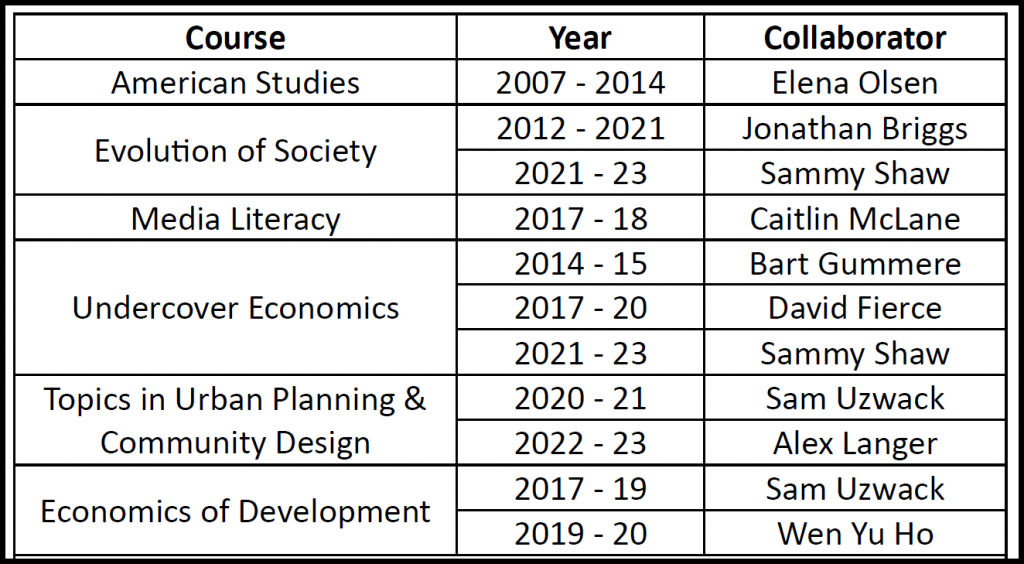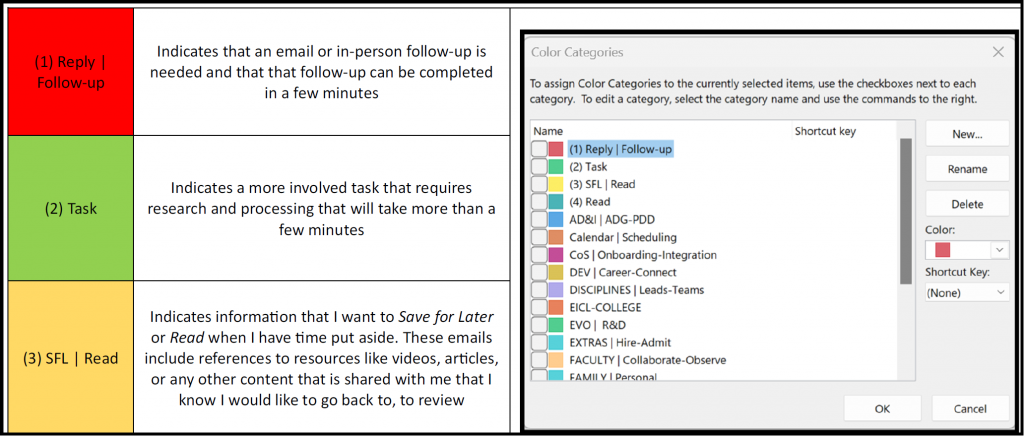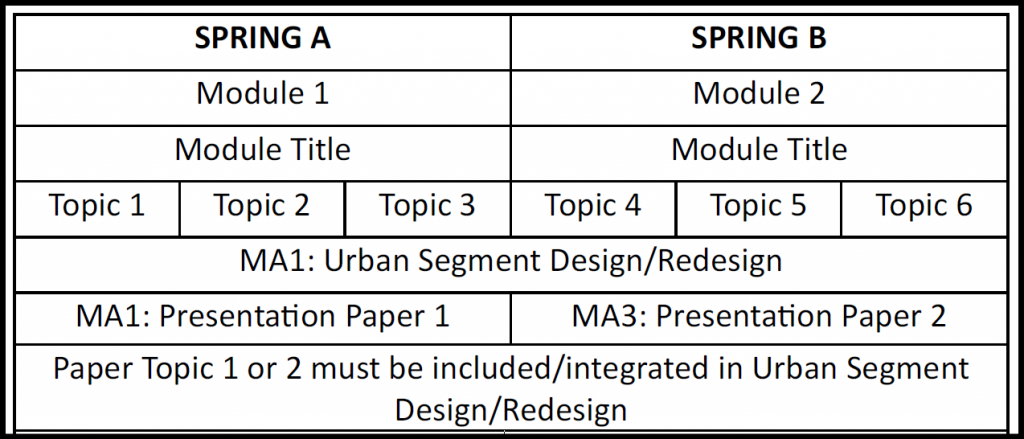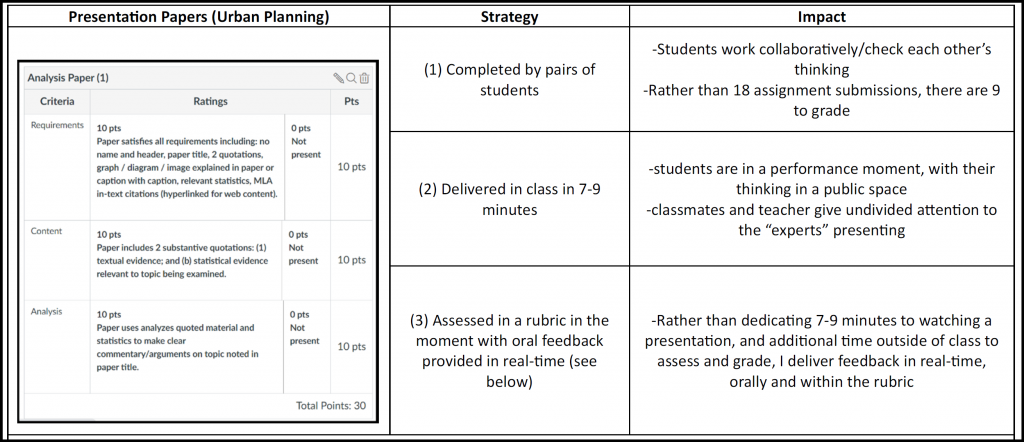The term professionalism is not often enough used in education. Teaching is both a complicated and complex domain. To do it well, we need to be able to abstract above the every day and think about why and how we do things. Executive functioning is our ability to organize our professional world, both internally and externally. Assessment practice falls under the umbrella of executive functioning. Both of these categories are incredibly personal, and essential to being a successful teacher. I appreciate being asked to reflect on these practices that are so often overlooked in the teaching world.
Professionalism-Executive Functioning |
How You Do Anything…
Observation → Feedback → Responsive Action
In my early days at EPS, colleagues visited my classes on a regular basis. It would not be uncommon for Adam Waltzer or Kirsten Pike to drop into my classes; Kirsten would grade in the back of my classroom as she passively took in the class experience. In a unique case, I didn’t realize until ten minutes into my Undercover Economics class, that Steve Fassino had been sitting amongst my students from the start of the class period. These colleagues visited my classes to see students in a different context, and to familiarize themselves with what I was teaching and how I was teaching. They visited with an openness to identifying integration opportunities and a desire to continue conversations that we had started in the office or at the breakfast table about teaching practices, strategies, and methodologies.
Regardless of the observer, I know that when colleagues visit my classroom: (1) my teaching performance and focus on my students improve as I respond to the positive pressure of a collegial audience, and (2) I receive feedback after class that helps me improve the next class, overall course design, and my teaching practice. Over my career at EPS, the primary visitor to/observer in my classes is the Head of Upper School; Bart Gummere during my first dozen years at EPS, and John Stegeman in more recent years.
John made an observational visit to my Undercover Economics classroom earlier this year. As we were debriefing, he mentioned that while I had written the agenda for the class on the board, had I taken more time to describe the roadmap for the class, my students might have had a better understanding of what they were going to learn and what they were going to be asked to do. Since that time, I have acted on this feedback returning to the detailed OneNote class agendas and descriptions that I used at the start of class during EPS Remote.
More recently, I have shared the Pedagogical Practice categories and indicators with my Urban Planning students with an ask that they provide feedback either at the end of class or when we discuss the efficacy of teaching and learning as we debrief as a full class.
Classroom visits by colleagues are less common today for several reasons including the depth of each faculty member’s varied responsibilities in the context of both a larger student body and faculty. This year, the privilege of having each of the different members of my PDP Feedback Team (Caitlin McLane, Terry Macaluso, Rick Mackenzie, Kate Lewellen, Krista Henningsen) visit my classes and provide feedback has been both meaningful and productive for me and my students.

Collaborative Course Alignment and Design
Whether teaching Undercover Economics, Evolution of Society, or Topics in Urban Planning & Community Design, I also benefit from collaboration with and feedback from colleagues who are teaching separate sections of these courses. Whether having a formal planning meeting or taking the opportunity to talk through class design and class sequence at breakfast or lunch, collaborating and exchanging with colleagues, never fails to help improve my practice.
As an aside, I also have an informal practice of sharing with any colleague who will listen when a class goes extremely well, or asking for support when a class experience does not meet my expectations.
Organization, Communication, and Execution
I manage tasks and professional responsibilities primarily in Outlook and OneNote, and one of my favorite pursuits is continuing to tune how I get things done by investigating different organization schemas, methodologies, and tools. I do this by reading books, listening to podcasts, and watching videos produced by organizational experts. More significant to my pursuit of organizational bliss is connecting with my colleagues to hear about how they organize themselves, prioritize tasks, and execute those tasks.
My Outlook calendar dictates the cadence of each day. I use colored categories to classify and tag calendar events by project or theme (see below). I also use categories to assign priority to any email that requires an action or generates a larger task. The Outlook categories which I use to prioritize my emails are the following.

Responsiveness Equals Respect
In the last year, a colleague shared a comment with me that has helped to crystallize how I think about timely communication, responsiveness equals respect. Although my inbox receives in excess of one hundred messages a day, I work to prioritize timely responses to students, parents, and colleagues. Outside of the work that I am doing for my classes, many of the emails I receive require me to have a conversation with a third party to determine how I would like to respond to those emails.
In past years, I would wait until I was able to have those third-party conversations before, I would respond to an initial email, often resulting in delayed responses to colleagues, students, or parents; likely wondering whether their original communication was received. I now respond immediately to students, parents and colleagues, letting them know that I have received their message and that it will take a little bit of time for me to get them a detailed and concrete response. This practice has increased my responsiveness and strengthened the signals of respect I send to people I am working to support.
As a teacher in the Upper School, I receive most email communication from my students, rather than their parents. Students in my classes contact me about absences, books and resources, and assignments/assessments. At the start of each academic term, I explain and emphasize to my students that if they would like to collaborate with me or connect with me about a particular assignment the best way to do so is to use the Add A Comment Box connected to each assignment submission in Canvas. Because Canvas and Outlook are integrated, anytime a student sends me a comment or question about a particular assignment, that comment comes directly to me as an email in my Outlook inbox. This allows me to immediately click into the assignment and get them a timely response.

The Weekly Wrap-up
Important to my approach to prioritization of e-mail communication is a one-hour time segment that I place in the afternoon every Friday of the school year. No meetings are scheduled in this time segment, so it can be dedicated to: (1) reviewing emails in each of the above three categories, following up when necessary, and making plans for how and when I am going to engage larger tasks. I also post homework on my class Canvas pages during this time. Setting aside this time block ensures that I leave each week responding to what I am able to and identifying what tasks I need to move to the following week.
Current and Future Practice
| # | Indicator | Area of |
| A.1 | Approaches recommendations for improvement receptively and responsively | Strength |
| A.2 | Displays openness and comfort with visitors observing class | Strength |
| A.3 | Seeks out diverse opinions of others for guidance | Strength |
| A.4 | Manages and prioritizes professional tasks and responsibilities | Improvement |
| A.5 | Communicates and responds to students, parents, and colleagues in a timely and constructive manner | Improvement |
Reflection
Organization, prioritization, and responsiveness are all areas in which I am working to improve daily. Receiving and providing timely and effective feedback to students and colleagues are particular areas of focus for me. The text Radical Candor emphasizes that timely and direct feedback, and responsiveness to feedback, is imperative to healthy professional exchange and continual growth. I continue to work intentionally to become a better listener, and to be more gracious, pointed, and specific in the feedback I share with colleagues and students. My hope is that we all see, feel, and understand how our success is connected to everyone else’s at EPS.
Assessment Practice | Feedback Loops
Time Commitment: Assessment & Feedback
Assessment is one of the most complex and challenging pieces of teaching. Early in my career, when I felt that I was behind in my course progressions, my tendency was to create more assignments and assign more work to my students and to myself. This practice made both parties even busier, often leading to a feeling of overwhelm. I wish that I had had a professor, a mentor, or a colleague who would have introduced me to a simple approach to gauge how much time in grading I was creating for myself each time I assigned a new piece of work to students.
In the first part of my career in a comprehensive public high school, I taught 5 sections of students and averaged 160 students each term. In my final and most challenging year in this setting, I had a 172-student load. I wish I had thought to create the simple matrix calculator below to determine how much grading time I was committing to when I published an assignment.

When I started teaching at Eastside Prep, I had four sections and 72 students a term. If I were focusing on a class of 18, to which I had assigned a three-page paper, and I estimated that it would take me 12 minutes to assess and grade each paper, I would have committed to 3.6 hours of grading. If I made that commitment for all 72 of my students, I would have committed to 14.4 hours of assessment and grading outside of the classroom.
Course & Assessment Design
Currently, in addition to my duties as Director of Academic Design & Integration, each term I teach: 1 section with a maximum of 18 students; 1 seminar with two colleagues and a maximum of 18 students; and 1-2 independent studies and/or a senior thesis.
I teach trimester courses, which average approximately 24 class periods in length, and in each course, I design and implement two to three module or unit plans. As I process the number of homework assignments students are going to do in a term, I assign no more than two outside-of-class assignments a week.
Where I used to assign both reading and written homework, responding to student feedback, I now design homework to ensure that students have read the course material, but are not overwhelmed at the amount of time they need to take completing a reading and authoring a written product.
The majority of homework assignments are discussion posts giving students the opportunity to see what important concepts their peers have identified in a reading. The public nature of the discussion groups raises each student’s accountability to our classroom marketplace of ideas, and the simplicity of the assignments makes it easier for me to grade with a credit/no credit approach which maps to the yellow highlighted portion of the matrix above (9-18 minutes total).
Major Assessment Integration
Each module includes a major assessment (MA:). Earlier in my career, I nested major projects in the final, two weeks of the term; a practice some educators macabrely call a post-mortem assessment. After receiving some feedback from colleagues on my module plans, I now work to stretch some of my major assessments over the course of the term.

For example, in Topics in Urban Planning & Community Design, there are three major assessments: two of those assessments are presentations where students choose the topics they would like to research, write about, and present to the class; and a third assessment that is a comprehensive Urban Segment Design/Redesign assignment, that spans the course, and asks students to incorporate a minimum of one of their presentation topics into their segment design. (see diagram) Each of these MA:s are posted on the class calendar as an assignment shell at the start of the term so that students are able to plan and manage their workloads across classes.

In-Real Time (IRT) Assessment
As much as possible, I assess and grade students in real-time. Where it makes sense, I partner students for major assessments so that there is an expectation for collaboration and exchange. For example, in Urban Planning at the start of each class period, a pair of students share what is called a Presentation-Paper.
This Presentation-Paper approach (1) increases student agency and choice; (2) ensures a diversity of 18 unique topics are engaged in each term; and (3) pairs each student with a new partner for each paper, ensuring that they have engaged three extensive collaborations with different peers by the end of the term. These paired products also reduce my grading load by 50%. This approach is discussed in more depth in both the Classroom Culture and Differentiated Instruction & Assessment sections.

Current and Future Practice
| # | Indicator | Area of |
| B.1 | Designs major assessments that reflect course outcomes and posts them at the start of each trimester | Strength |
| B.2 | Designs assignments to be graded and returned in a feedback cycle of seven calendar days | Improvement |
| B.3 | Ensures the number of assignments in each course is neither excessive nor deficient–providing appropriate time for quality student performance and meaningful teacher feedback | Strength |
Reflection
As I think about future growth in this area, I am focused on two elements. The first is ensuring I get feedback to students on assessments within the seven-day calendar guideline that all teachers map to at Eastside Prep. The second is providing students feedback and time to process that feedback in class so that I know they are focusing consistently on improvement, and that the time I’ve spent assessing their work and performance was worth the time investment.